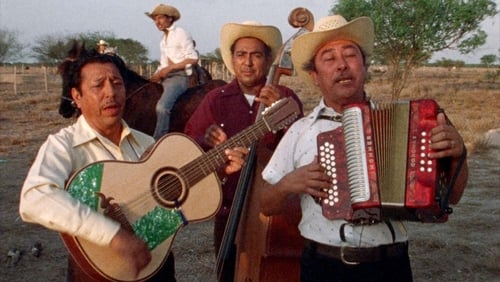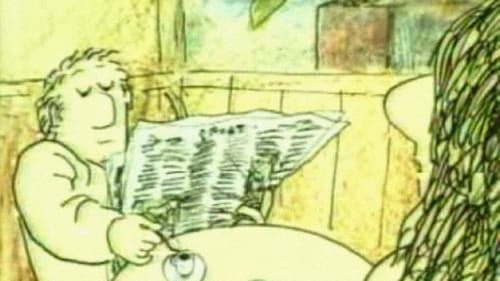Rabbit (2005)
Genre : Animation
Runtime : 9M
Director : Run Wrake
Synopsis
A tale of lost innocence, greed and the random justice of nature. When a boy and girl find an idol in the stomach of a rabbit, its magical abilities lead to riches. But for how long?

Felix in Exile introduces a new character to the 'Drawings for Projection' series: Nandi, an African woman, who appears at the beginning of the film making drawings of the landscape. She observes the land with surveyor's instruments, watching African bodies, with bleeding wounds, which melt into the landscape. She is recording the evidence of violence and massacre that is part of South Africa's recent history. Felix Teitelbaum, who features in Kentridge's first and fourth films as the humane and loving alter-ego to the ruthless capitalist white South African psyche, appears here semi-naked and alone in a foreign hotel room, brooding over Nandi's drawings of the damaged African landscape, which cover his suitcase and walls. Kentridge has commented: 'Felix in Exile was made at the time just before the first general election in South Africa, and questioned the way in which the people who had died on the journey to this new dispensation would be remembered'.

In this child's game, a live-action boy and girl draw characters and compete who is better. The girl draws a flower and the boy draws a car that runs it over. Then a drawn lion chases a drawn girl, until it all becomes frightfully serious.

A little girl wanders all alone in the morning, through a bustling city, looking for the white bells she noticed in the window of a florist's shop. This film heralded the birth of a new film language in Latvian cinema. It received awards at the San Francisco and Oberhausen festivals. and was included on the list of the “world’s 100 best short films” by the film critics at the 1995 Clermont-Ferrand film festival.. All three of the film’s authors together with their peers became the creators of the legendary Riga School of Poetic Documentary.

A complex, insightful look at the Chicano experience as mirrored in the lives and music of the most acclaimed Norteño musicians of the Texas-Mexican border, including Flaco Jimenez and Lydia Mendoza. Video includes bonus feature, Del Mero Corazon.

A short film in which pieces of paper fly off of an animated cube.

A short film by Walerian Borowczyk. Ostensibly a film of a concert given by the round, unassuming Monsieur Kabal and his spiky, terrifying wife, it's actually a cover for their frequent attempts at causing each other extreme physical harm.

The fauna of the megalopolis, the jungle of the supermarket, the bedlam of brothels and bars, the effect of the bars in the fog, the swaying ears of corn, the swaying of men hanging from the gallows, the ripple of water – seen by the eye of the animator…

It is one of the most stirring animated films in the history of animation. In a simple, but powerful way Czekala presents a horror that happened in concentration camps – prisoners’ dread, humiliation and lost humanity. The everyday roll-call ends tragically because of prisoners’ “insubordination” in this black and white film. The Roll-Call crossed borders of what can be presented or not in animation. It is sometimes interpreted as a response to the trend of allegorical and philosophical films that dominated in Polish animation in 1960s.

Motion Painting No. 1 is a 1947 experimental short animated film in which film artist Oskar Fischinger put images in motion to the music of Johann Sebastian Bach’s Brandenburg Concerto no. 3, BWV 1048. It is a film of a painting (oil on acrylic glass); Fischinger filmed each brushstroke over the course of 9 months. In 1997, this film was selected for inclusion in the United States National Film Registry by the Library of Congress as being “culturally, historically, or aesthetically significant”.

Hand-painted 35 mm stock photographed in 16 mm, color, 3:20 or 10 min. Reportedly cut down from about 30 min. Initially intended to be screened with and synchronized to Dizzy Gillespie's Guarachi Guaro or Manteca. "Batiked animation made of dead squares...".

In the 1936 short Allegretto, diamond and oval shapes in primary colors perform a sensual, upbeat ballet to the music of composer Ralph Rainger. The geometric dance is set against a background of expanding circles that suggest radio waves.

A haunting look at children watching television.

With the screen split asymmetrically, one part in positive, the other negative, the film documents the evolution of simple celled organic forms into chains of cells then more complex images from tribal cultures and contemporary modernist concepts. The images react, interpenetrate, perhaps attack, absorb and separate, until a final symbiosis (or redemption?) is achieved.

A man and a woman converse at a cafe's bar in this animated short.

Director Joseph Cornell evokes the nostalgia of childhood by filming a children's party.

With a similar dreamy mood like its predecessor "Take the 5:10 to Dreamland" (1976) this clip starts with a boy getting into his bed. The camera zooms in into the boy's mind and a slow, sad waltz (i.e."Valse Triste") accompanies images of a locomotive, a miner, the globe, the sky, a sheep heard, etc. Disparate elements, but if one concentrates only at the movement of the figures, one can perceive a commotion, slowly livening up: The starting wheels of the heavy locomotive, the tired miner pushing the heavy cart of coal bricks, the globe smoothly turning around and around, the clouds imperceptibly floating in the sky, the sheep idly moving in the herd, etc. We reach the first climax when a mannequin opens her coat like a flower. The second big crescendo spurts out from a "water hose", after watching schoolgirls doing gymnastics for quite a while. A sad, but nostalgic aftertaste lingers in the end when funeral cars drive away through a flooded area…

Bold and innovative animation takes drawing into the real world.

In eight minutes, animator Bill Plympton gives us 24 vignettes: seven are clearly about sex, 10 about violence, and seven others deal with human frailties, particularly the body as it ages. There are three stories of persons with confused priorities (including a guy tying his shoe while parachuting); the world's first phone sex; and a clever, if dangerous, way to find a lost key. Except for the titles of each sketch and a couple of jokes that turn on noise, these are visual trips into the psyche of men, women, God, animals, and Time (the enemy of us all).

A short Surrealist animation from Denmark which begins with a zoom into a Paul Delvaux painting, then reverses the process by pulling back from a continually changing picture.





